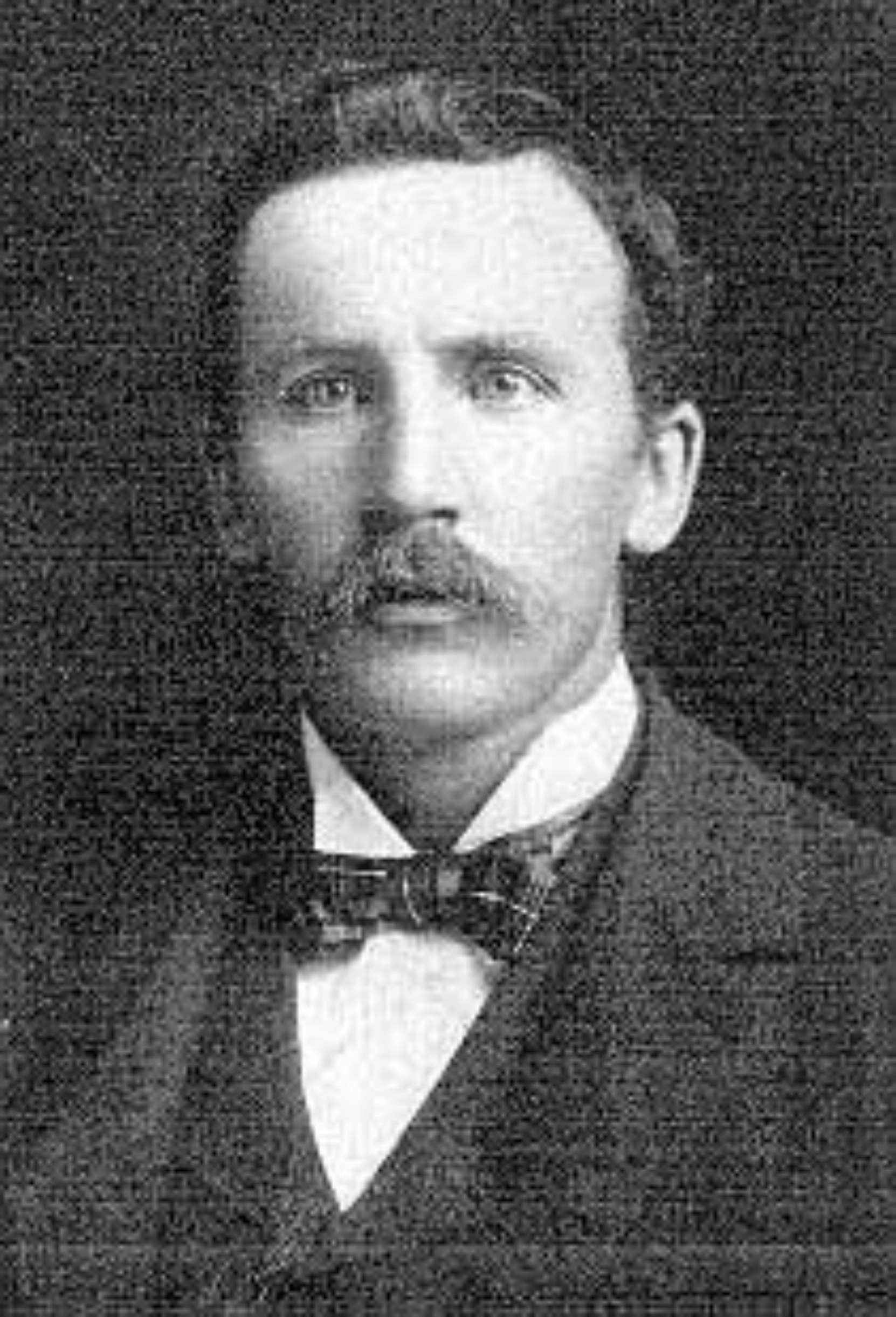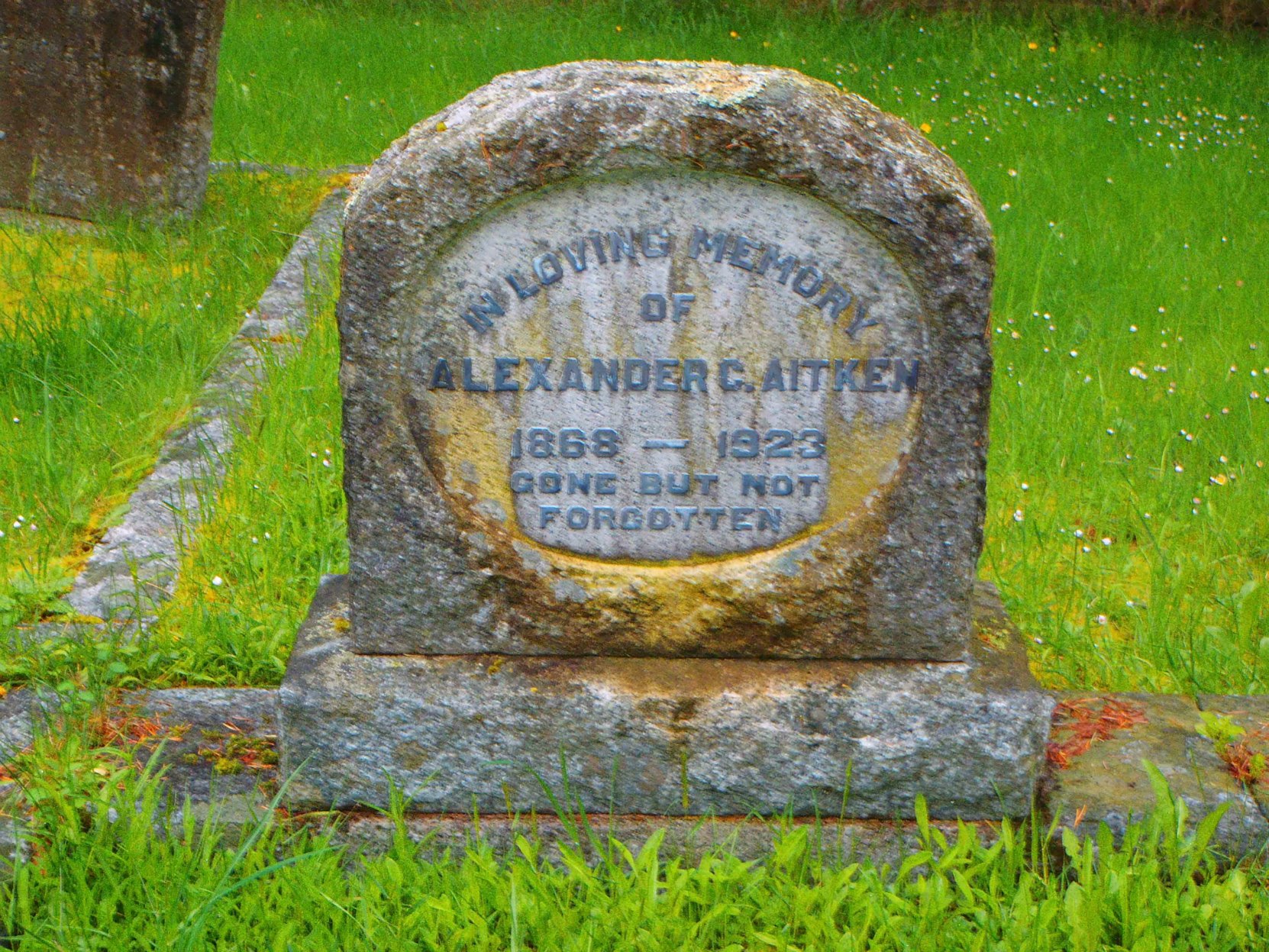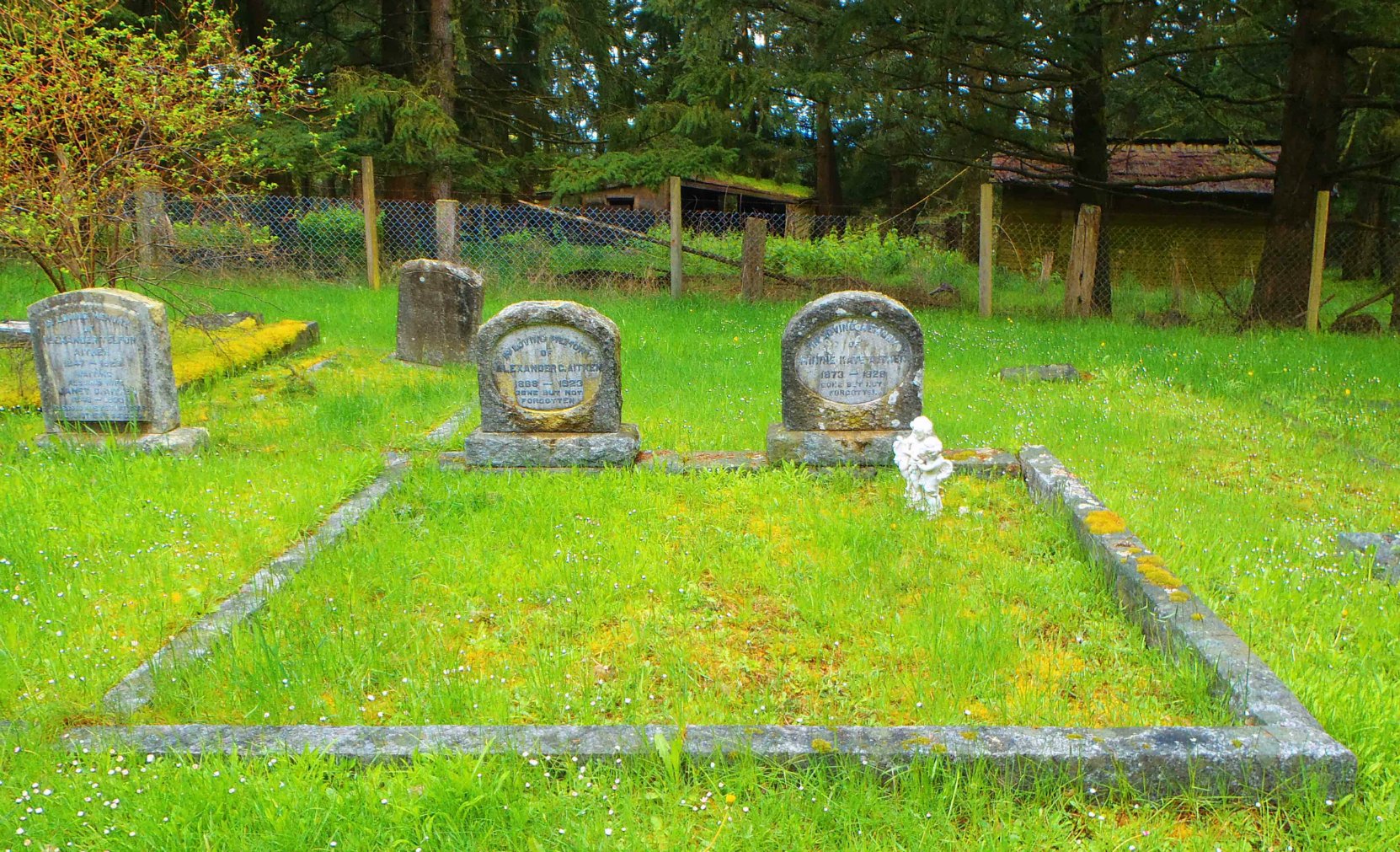Alexander Chalmers Aitken (1868-1923) was initiated an Entered Apprentice in Temple Lodge, No. 33 in 1910. He was passed and Raised in 1911. He remained a member of Temple Lodge, No. 33 until his death in 1923.

Alexander Aitken was a successful farmer at Maple Bay, B.C. He was also active in civic affairs, serving on North Cowichan District Council as a Councillor in 1907, 1908 and 1919 and as Reeve (or Mayor) of North Cowichan in 1909, 1910, 1911 and 1923. He was Reeve of North Cowichan in 1911 when the movement to incorporate the City of Duncan began in earnest.
Alex Aitken Elementary School is named for Alexander Chalmers Aitken.
Here is a brief biography of Alexander Chalmers Aitken taken from local newspaper reports of his death and funeral and an article by local historian T.W. Paterson:
“Aitken – It was a great shock to residents to learn of the sudden demise of Reeve Aitken on Monday night. It was his custom to from his home most evenings to spend a little while at the house of his neighbour, Mrs. Easton.
He was telephoning to Constable Beard at 6:30 p.m. At 7 p.m., having just come up from his home, he entered the kitchen, and was chatting in his usual cheery way with Miss Easton and her sister, when he stood upright and then gradually sank in death. Dr. H.P. Swan, coroner, found death due to natural causes.
Mr. Aitken had planned to help his neighbours with a cow but he was prevented from carrying out what to him was but a little thing but which was typical of his unselfishness and true neighbourly spirit.
Alexander Chalmers Aitken was born in Scotland and would have been fifty-five had he lived another month. He came out to Vancouver Island when twenty and began work near Victoria where he was employed on the Rogers farm. Later he went to work for the Musgraves on Salt Spring Island and, when they moved to Somenos lake, he accompanied them. This was thirty-one years ago.
Later, when the Musgraves left, Mr. Aitken purchased half their property. He sold several pieces and retained his present farm for himself. He was known as a good, all-round farmer, but it is through his connection with sheep that his name will always be remembered.
In him, the Vancouver Island Flockmasters’ Association loses one who has held the office of secretary for many years. He was more than a mere secretary or one who cared for the society’s rams.
The sheepmen of the island owe him a great deal of gratitude for the enlightened and unselfish policy he pursued with regard to their affairs. He was a tremendous advocate of co-operation and when the time came to merge the V.I.F.A. wool sales with the national organization his ability was recognized by the high office he attained with the B.C. Wool Growers’ association – that of vice president.
In municipal life, Mr. Aitken has taken perhaps as large a share as any in North Cowichan. Though not consecutive this was the sixth year he was serving as reeve. He had also acted as a councillor for six terms. Three times as reeve and four times as councillor he was returned by acclamation.
Mr. Aitken was one of the charter members of Duncan Lodge, No. 17 I.O.O.F., and was a P.G. [note: Past Grand] in the order. He was also a member of Temple Lodge, No. 33, A.F. & A.M., and of Maple Lodge, No. 15, K. of P [note: Knights of Pythias].
Mr. Aitken leaves a widow and one son, Edward. His father and mother, Mr. And Mrs. Alexander Aitken, followed him out here and are still resident at Maple Bay. He has three brothers and a sister in the district. To all his relatives the deep sympathy of the district goes out in this sudden bereavement.
The funeral takes place at the Methodist burying ground, Maple Bay, leaving the house at 1:30 p.m.”
(Source: Cowichan Leader, 15 February 1923 from Cowichan Valley Museum & Archives collections)
“Aitken – The funeral of the late Mr. A.C. Aitken took place on Thursday afternoon, under as difficult weather and road conditions as could well be conceived. The coffin was conveyed on a sleigh from the home on Maple Bay to the Maple Bay Methodist cemetery. This burial ground is on the site of the old log church which stood there some forty years ago. Even under good weather conditions it is not easily accessible as one has to pass through some bush.
On Thursday a great deal of difficulty was encountered by those who came to pay their last respects to Mr. Aitken. Yet there were between twenty and thirty people present. They had come in sleighs, cutters and on horseback.
Duncan Lodge, No. 17, I.O.O.F., was in charge of the funeral. That part of the order’s service at the graveside was taken by Noble Grand William Evans and Chaplain L.C. Brockway. The Rev. J.R. Butler conducted the church service.
The pallbearers were Messrs. D.R. Hattie, O.C. Brown, J.C. McLay, R.S. Cowie, J. Murchie and John Blyth, all members of the I.O.O.F. The funeral arrangements were in the hands of Mr. R.H. Whidden.”
(Source: Cowichan Leader, 23 February 1923 from Cowichan Valley Museum & Archives collections)
Local Cowichan Valley historian Tom Paterson (T.W. Paterson) wrote this article on Alexander Aitken for his weekly Cowichan Chronicles column in the Cowichan Valley Citizen. It appeared in the Cowichan Valley Citizen, 30 January 2013, page 9.
“Reeve Alexander Aitken’s sudden passing “shocked residents” in February 1923.
If there’s one thing about history that galls me, it’s that it seldom quits. By that I mean, rarely, rarely can I say done, finished — case closed. Almost always, should I presume to think so, some new information comes to hand. In short, my files are seldom “filed” for long.
Which is all well and good, in its own way, but it does upset my instinctive desire to finish a job. Which probably explains why my first ambition was to be a carpenter. Even as a child I recognized that, when a carpenter’s work is done — it’s done.
A case in point is my recently released book on Cowichan Valley cemeteries. To compile Tales the Tombstones Tell took hundreds of hours of archival research over a 30-year period and scores of trips to the Valley’s 16 public/church cemeteries with notebook and camera in hand(s). It’s not meant to be a “complete” accounting of all the thousands who are interred locally, of course, any more than, in all practicality, it could be.
But I did go to press comfortable in the belief that I’d covered the ground, so to speak, to a desired degree of thoroughness.
Enter Mark Anderson, Senior Warden and historian of Duncan’s Masonic Temple Lodge No. 33. In helping me with my researching the heritage homes and buildings of Duncan for a forthcoming book, he generously passed on a thick file giving a history of the Duncan Lodge including the biographies and, where applicable, the obituaries of its most prominent members over the past 112 years. Mmmmph.
How could I have been so blind. I mean, Maple Bay’s Pioneer Cemetery, off Herd Road, is small enough, there aren’t enough graves there to overwhelm me as is the case with our larger graveyards.
Numerous of the pioneering Aitken family are here and I did mention three of them, Alexander Strachan, Malcolm and George A., briefly. But not a word about Alexander Chalmers Aitken, reeve of North Cowichan.
So, today, thanks to Mark Anderson, something about Mr. Aitken whose sudden passing “shocked residents” in February I 1923: “It was his custom to [go] from his house most evenings to spend a little while at the house of his neighbour, Mrs. Easton,” the Cowichan Leader account of the day tells us. “He was telephoning to Const. Beard at 6:30 p.m. At 7 p.m., having just come up from his home, he entered the kitchen, and was chatting in his usual cheery way with Miss Easton and her sister, when he stood upright and then gradually sank in death. Dr. H.P. Swan, coroner, found death due to natural causes.”
Greatly shocked indeed, must have been the Eastons. Aitken was just a month short of his 55th birthday.
Born in Scotland, he’d arrived on the Island at age 20 and after working briefly on a Saanich farm found employment with the Musgrave family on their Saltspring Island property. He accompanied them to their large estate on the east side [Lakes Road area] of Somenos Lake, in 1892. When the Musgraves left the Valley, Aitken purchased half their holdings, subdivided and sold some parcels and operated his own farm on the balance.
Known as a good, all-round farmer, he was particularly interested in sheep. In fact, it was said that “the sheepmen of the Island owe him a great deal of gratitude for the enlightenment and unselfish, policy he pursued with I regard to their affairs. He was a tremendous advocate of co-operation and when the time came to merge the [Vancouver Island Flockmasters Association] wool sales with the national organization his ability was recognized by the high office he attained with the B.C. Wool Growers’ Association…that of vice president.”
In the civic arena, Aitken had “perhaps as large a share as any in North Cowichan. Though not consecutive, this was the sixth year he was serving as reeve. He had also acted as a councillor for six terms. Three times as reeve and four times as councillor he was returned by acclamation.”
Alexander Chalmers Aitken left a wife and son, three brothers and a sister and both parents in the Valley. His funeral in the old Methodist cemetery took place “under as difficult weather and road conditions as could well be imagined,” the coffin having to be conveyed from the family home by horse-drawn sleigh.
If the fact that fewer than 30 people at his service seems to be a disappointing turnout, it was because of the wretched weather conditions, all (like Aitken’s coffin) having had to arrive by sleigh, cutter or on horseback. Duncan Lodge, No.17, I.O.O.F. was in charge of the service and the Rev. J.R. Butler conducted the graveside service, funeral arrangements having been in the able hands of former wheelwright cum undertaker, R.H. Whidden.
So, my apologies to Reeve Aitken for not including him in my book. As stated, I did mention Malcolm Aitken, 1916- 1994, and George A. Aitken, 1908- 1948, whose half-sized headstone catches the eye. Usually, small headstones denote the grave of a child; this is hardly the case of 40-year-old George. The headstone for Alexander Strachan Aitken, 1919-1931, stands out even more as it’s pinkish-orange and in the shape of a heart.
Sorry, Reeve Mr. Aitken; maybe next time. At least they haven’t forgotten you at Alex Aitken Elementary School.”
(Source: www.twpaterson.com)


Would you like to leave a comment or question about anything on this page?
Your message has been sent